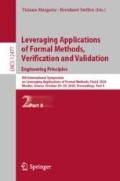Abstract
We introduce and discuss a formal model of evolutionary processes that summarizes various kinds of evolutionary algorithms and other optimization techniques. Based on that framework, we present assumptions called “random agnosticism” and “based optimism” that allow for new kinds of proofs about evolution. We apply them by providing all a proof design that the recently introduced notion of final productive fitness is the ideal target fitness function for any evolutionary process, opening up a new perspective on the fitness in evolution.
Access this chapter
Tax calculation will be finalised at checkout
Purchases are for personal use only
Notes
- 1.
In computers, these are often provided by a seed value and a hash function.
- 2.
Note that by giving a function only parametrized on the individual itself, we assume that the target function is static. Dynamic optimization is an entire field of research that we heavily use in this paper. However, we leave dynamic target functions in our formalism to future work.
- 3.
In the field of evolutionary computing, this is called a \(\mu + \lambda \) selection scheme.
- 4.
The code for all examples can be found at github.com/thomasgabor/isola-evolib.
- 5.
Note that the best possible choice for the average fitness of descendants is the minimum of the possible descendants’ fitness values. When we are allowed to adjust the random choice for the best possible outcomes, worse-than-optimal children will not be born. This changes the game: Our ideal choice from the vast space of random possibilities now yields at most one (i.e. the best possible) descendant per individual per generation.
- 6.
Note that \(t(x)\) cannot be compensated by other descendants of \(x'\) with possibly bad objective fitness since we assumed optimistic final productive fitness following Assumption 2.
- 7.
For details on how this is done, please refer to [8].
- 8.
Migrants are generated randomly and are thus not ascribed to be any individual’s descendant. How to include migrants in productive fitness is left for future work.
- 9.
As no computational limit on biological evolution, e.g., has been recognized it could be an interesting endeavor to use the framework presented in this paper to translate arguments from runtime analysis of evolutionary algorithms back to a more general concept of evolution.
References
Brown, G., Wyatt, J., Harris, R., Yao, X.: Diversity creation methods: a survey and categorisation. Inf. Fusion 6(1), 5–20 (2005)
DEAP Project: Benchmarks (2020). https://deap.readthedocs.io/en/master/api/benchmarks.html. Accessed June 1 2020
Dewey, D.: Reinforcement learning and the reward engineering principle. In: 2014 AAAI Spring Symposium Series (2014)
Doerr, B., Happ, E., Klein, C.: Crossover can provably be useful in evolutionary computation. Theoret. Comput. Sci. 425, 17–33 (2012)
Droste, S., Jansen, T., Wegener, I.: On the analysis of the (1+1) evolutionary algorithm. Theoret. Comput. Sci. 276(1–2), 51–81 (2002)
Friedrich, T., Oliveto, P.S., Sudholt, D., Witt, C.: Analysis of diversity-preserving mechanisms for global exploration. Evol. Comp. 17(4), 455–476 (2009)
Gabor, T., Belzner, L., Linnhoff-Popien, C.: Inheritance-based diversity measures for explicit convergence control in evolutionary algorithms. In: Genetic and Evolutionary Computation Conference, pp. 841–848 (2018)
Gabor, T., Phan, T., Linnhoff-Popien, C.: Productive fitness in diversity-aware evolutionary algorithms (2021). (submitted)
Hadfield-Menell, D., Milli, S., Abbeel, P., Russell, S.J., Dragan, A.: Inverse reward design. In: Advances in Neural Information Processing Systems, pp. 6765–6774 (2017)
Ho, Y.C., Pepyne, D.L.: Simple explanation of the no free lunch theorem of optimization. In: 40th IEEE Conference on Decision and Control (Cat. No. 01CH37228), vol. 5, pp. 4409–4414. IEEE (2001)
Hu, T., Banzhaf, W.: Evolvability and speed of evolutionary algorithms in light of recent developments in biology. J. Artif. Evol. Appl. 2010, 1 (2010)
Rainville, D., Fortin, F.A., Gardner, M.A., Parizeau, M., Gagné, C., et al.: Deap: a python framework for evolutionary algorithms. In: Conference Companion on Genetic and Evolutionary Computation, pp. 85–92. ACM (2012)
Stephens, C.R.: “Effective” fitness landscapes for evolutionary systems. In: 1999 Congress on Evolutionary Computation (CEC 1999), vol. 1, pp. 703–714. IEEE (1999)
Van Soest, A.K., Casius, L.R.: The merits of a parallel genetic algorithm in solving hard optimization problems. J. Biomech. Eng. 125(1), 141–146 (2003)
Wineberg, M., Oppacher, F.: The underlying similarity of diversity measures used in evolutionary computation. In: Cantú-Paz, E., et al. (eds.) GECCO 2003. LNCS, vol. 2724, pp. 1493–1504. Springer, Heidelberg (2003). https://doi.org/10.1007/3-540-45110-2_21
Author information
Authors and Affiliations
Corresponding author
Editor information
Editors and Affiliations
Rights and permissions
Copyright information
© 2020 Springer Nature Switzerland AG
About this paper
Cite this paper
Gabor, T., Linnhoff-Popien, C. (2020). A Formal Model for Reasoning About the Ideal Fitness in Evolutionary Processes. In: Margaria, T., Steffen, B. (eds) Leveraging Applications of Formal Methods, Verification and Validation: Engineering Principles. ISoLA 2020. Lecture Notes in Computer Science(), vol 12477. Springer, Cham. https://doi.org/10.1007/978-3-030-61470-6_28
Download citation
DOI: https://doi.org/10.1007/978-3-030-61470-6_28
Published:
Publisher Name: Springer, Cham
Print ISBN: 978-3-030-61469-0
Online ISBN: 978-3-030-61470-6
eBook Packages: Computer ScienceComputer Science (R0)

